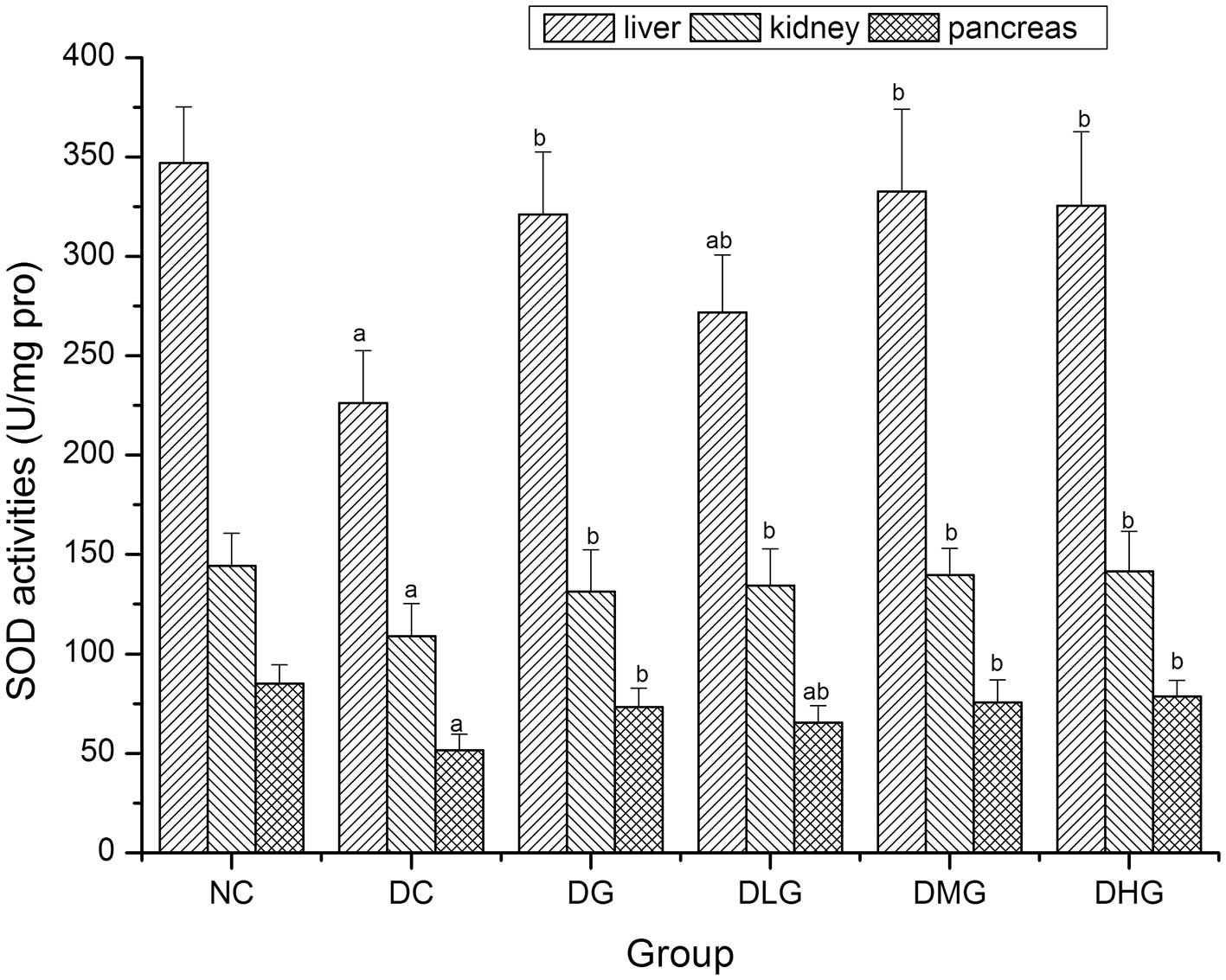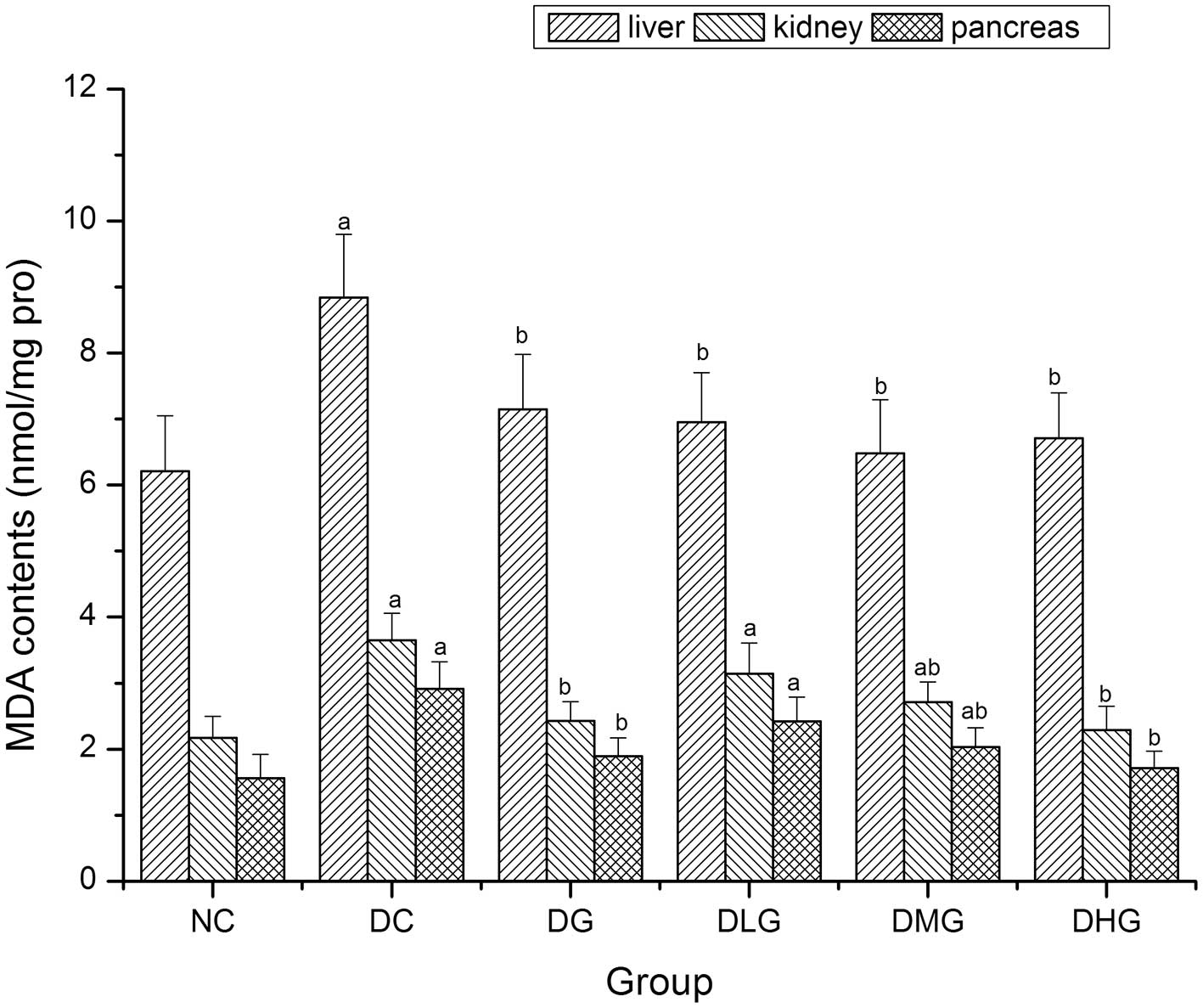|
1
|
El-Alfy AT, Ahmed AA and Fatani SAJ:
Protective effect of red grape seeds proanthocyanidins against
induction of diabetes by alloxan in rats. Pharmacol Res.
52:264–270. 2005. View Article : Google Scholar : PubMed/NCBI
|
|
2
|
Li F, Tang H, Xiao F, et al: Protective
effect of salidroside from Rhodiolae radix on
diabetes-induced oxidative stress in mice. Molecules. 16:9912–9924.
2011.
|
|
3
|
Zhang ZF, Lv GY, Pan HJ, et al:
Antidiabetic activities of ethanol extract of dry matters of
culture broth of Coriolus versiolor in submerged culture.
Braz Arch Biol Technol. 54:701–708. 2011. View Article : Google Scholar
|
|
4
|
Li WL, Zheng HC, Bukuru J and De Kimpe N:
Natural medicines used in the traditional Chinese medical system
for therapy of diabetes mellitus. J Ethnopharmacol. 92:1–21. 2004.
View Article : Google Scholar : PubMed/NCBI
|
|
5
|
Tang LQ, Wei W, Chen LM and Liu S: Effects
of berberine on diabetes induced by alloxan and a
high-fat/high-cholesterol diet in rats. J Ethnopharmacol.
108:109–115. 2006. View Article : Google Scholar : PubMed/NCBI
|
|
6
|
Luo Q, Cai Y, Yan J, et al: Hypoglycemic
and hypolipidemic effects and antioxidant activity of fruit
extracts from Lycium barbarum. Life Sci. 76:137–149. 2004.
View Article : Google Scholar : PubMed/NCBI
|
|
7
|
Lü H, Chen J, Li WL, et al: Hypoglycemic
effect of the total flavonoid fraction from folium
Eriobotryae. Phytomedicine. 16:967–971. 2009.PubMed/NCBI
|
|
8
|
Liu Z, Wang LJ, Li X, et al: Hypoglycemic
effects of malonyl-ginsenosides extracted from roots of Panax
ginseng on streptozotocin-induced diabetic mice. Phytother Res.
23:1426–1430. 2009. View
Article : Google Scholar : PubMed/NCBI
|
|
9
|
Qi LW, Liu EH, Chu C, et al: Anti-diabetic
agents from natural products - an update from 2004 to 2009. Curr
Top Med Chem. 10:434–457. 2010. View Article : Google Scholar : PubMed/NCBI
|
|
10
|
Patel MB and Mishra S: Hypoglycemic
activity of alkaloidal fraction of Tinospora cordifolia.
Phytomedicine. 18:1045–1052. 2011. View Article : Google Scholar : PubMed/NCBI
|
|
11
|
Tian ML, Yan HY and Row KH: Simultaneous
extraction and separation of liquiritin, glycyrrhizic acid, and
glabridin from licorice root with analytical and preparative
chromatography. Biotechnol Bioprocess Eng. 13:671–676. 2008.
View Article : Google Scholar
|
|
12
|
Sabbioni C, Mandrioli R, Ferranti A, et
al: Separation and analysis of glycyrrhizin, 18beta-glycyrrhetic
acid and 18alpha-glycyrrhetic acid in liquorice roots by means of
capillary zone electrophoresis. J Chromatogr A. 1081:65–71. 2005.
View Article : Google Scholar : PubMed/NCBI
|
|
13
|
Mori H, Niwa K, Zheng Q, et al: Cell
proliferation in cancer prevention; effects of preventive agents on
estrogen-related endometrial carcinogenesis model and on an in
vitro model in human colorectal cells. Mutat Res. 480–481:201–207.
2001.
|
|
14
|
Yokozawa T, Cho EJ, Rhyu DY, et al:
Glycyrrhizae Radix attenuates peroxynitrite-induced renal
oxidative damage through inhibition of protein nitration. Free
Radic Res. 39:203–211. 2005. View Article : Google Scholar
|
|
15
|
Lee JY, Lee JH, Park JH, et al:
Liquiritigenin, a licorice flavonoid, helps mice resist
disseminated candidiasis due to Candida albicans by Th1
immune response, whereas liquiritin, its glycoside form, does not.
Int Immunopharmacol. 9:632–638. 2009. View Article : Google Scholar : PubMed/NCBI
|
|
16
|
Shang H, Cao S, Wang J, et al: Glabridin
from Chinese herb licorice inhibits fatigue in mice. Afr J Tradit
Complement Altern Med. 7:17–23. 2009.PubMed/NCBI
|
|
17
|
Choi EM: The licorice root derived
isoflavan glabridin increases the function of osteoblastic MC3T3-E1
cells. Biochem Pharmacol. 70:363–368. 2005. View Article : Google Scholar : PubMed/NCBI
|
|
18
|
Sharma S, Kulkarni SK, Agrewala JN and
Chopra K: Curcumin attenuates thermal hyperalgesia in a diabetic
mouse model of neuropathic pain. Eur J Pharmacol. 536:256–261.
2006. View Article : Google Scholar : PubMed/NCBI
|
|
19
|
Hwang HJ, Kim SW, Lim JM, et al:
Hypoglycemic effect of crude exopolysaccharides produced by a
medicinal mushroom Phellinus baumii in
streptozotocin-induced diabetic rats. Life Sci. 76:3069–3080. 2005.
View Article : Google Scholar : PubMed/NCBI
|
|
20
|
Hayashi K, Kojima R and Ito M: Strain
differences in the diabetogenic activity of streptozotocin in mice.
Biol Pharm Bull. 29:1110–1119. 2006. View Article : Google Scholar : PubMed/NCBI
|
|
21
|
Sarkhail P, Rahmanipour S, Fadyevatan S,
et al: Antidiabetic effect of Phlomis anisodonta: effects on
hepatic cells lipid peroxidation and antioxidant enzymes in
experimental diabetes. Pharmacol Res. 56:261–266. 2007.
|
|
22
|
Li F, Li Q, Gao D and Peng Y: The optimal
extraction parameters and anti-diabetic activity of flavonoids from
Ipomoea batatas leaf. Afr J Tradit Complement Altern Med.
6:195–202. 2009.PubMed/NCBI
|
|
23
|
Li F, Zhang Y and Zhong Z:
Antihyperglycemic effect of ganoderma lucidum polysaccharides on
streptozotocin-induced diabetic mice. Int J Mol Sci. 12:6135–6145.
2011. View Article : Google Scholar : PubMed/NCBI
|
|
24
|
Raghavan B and Kumari SK: Effect of
Terminalia arjuna stem bark on antioxidant status in liver
and kidney of alloxan diabetic rats. Indian J Physiol Pharmacol.
50:133–142. 2006.
|
|
25
|
Ha H, Hwang IA, Park JH and Lee HB: Role
of reactive oxygen species in the pathogenesis of diabetic
nephropathy. Diabetes Res Clin Pract. 82(Suppl 1): S42–S45. 2008.
View Article : Google Scholar : PubMed/NCBI
|
|
26
|
Cemek M, Kağa S, Simşek N, et al:
Antihyperglycemic and antioxidative potential of Matricaria
chamomilla L. in streptozotocin-induced diabetic rats. J Nat
Med. 62:284–293. 2008.
|















